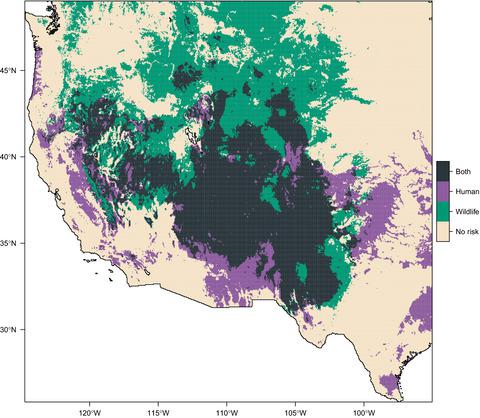当前位置:
X-MOL 学术
›
Glob. Change Biol.
›
论文详情
Our official English website, www.x-mol.net, welcomes your feedback! (Note: you will need to create a separate account there.)
Plague risk in the western United States over seven decades of environmental change
Global Change Biology ( IF 11.6 ) Pub Date : 2021-11-18 , DOI: 10.1111/gcb.15966 Colin J Carlson 1 , Sarah N Bevins 2 , Boris V Schmid 3
Global Change Biology ( IF 11.6 ) Pub Date : 2021-11-18 , DOI: 10.1111/gcb.15966 Colin J Carlson 1 , Sarah N Bevins 2 , Boris V Schmid 3
Affiliation

|
After several pandemics over the last two millennia, the wildlife reservoirs of plague (Yersinia pestis) now persist around the world, including in the western United States. Routine surveillance in this region has generated comprehensive records of human cases and animal seroprevalence, creating a unique opportunity to test how plague reservoirs are responding to environmental change. Here, we test whether animal and human data suggest that plague reservoirs and spillover risk have shifted since 1950. To do so, we develop a new method for detecting the impact of climate change on infectious disease distributions, capable of disentangling long-term trends (signal) and interannual variation in both weather and sampling (noise). We find that plague foci are associated with high-elevation rodent communities, and soil biochemistry may play a key role in the geography of long-term persistence. In addition, we find that human cases are concentrated only in a small subset of endemic areas, and that spillover events are driven by higher rodent species richness (the amplification hypothesis) and climatic anomalies (the trophic cascade hypothesis). Using our detection model, we find that due to the changing climate, rodent communities at high elevations have become more conducive to the establishment of plague reservoirs—with suitability increasing up to 40% in some places—and that spillover risk to humans at mid-elevations has increased as well, although more gradually. These results highlight opportunities for deeper investigation of plague ecology, the value of integrative surveillance for infectious disease geography, and the need for further research into ongoing climate change impacts.
中文翻译:

美国西部七十年环境变化的鼠疫风险
在过去两千年的几次大流行之后,鼠疫的野生动物宿主(耶尔森鼠疫) 现在在世界各地持续存在,包括在美国西部。该地区的常规监测已经产生了人类病例和动物血清阳性率的全面记录,为测试鼠疫宿主如何应对环境变化创造了独特的机会。在这里,我们测试动物和人类数据是否表明自 1950 年以来鼠疫宿主和溢出风险发生了变化。为此,我们开发了一种新方法来检测气候变化对传染病分布的影响,能够解开长期趋势。信号)和天气和采样(噪声)的年际变化。我们发现鼠疫疫源与高海拔啮齿动物群落有关,土壤生物化学可能在长期持续存在的地理中发挥关键作用。此外,我们发现人类病例仅集中在一小部分流行地区,并且溢出事件是由较高的啮齿动物物种丰富度(扩增假设)和气候异常(营养级联假设)驱动的。使用我们的检测模型,我们发现由于气候变化,高海拔的啮齿动物群落变得更有利于建立鼠疫水库——在某些地方适宜性提高了 40%——而中期对人类的溢出风险海拔也增加了,虽然更加缓慢。这些结果突出了对瘟疫生态学进行更深入调查的机会,传染病地理综合监测的价值,以及进一步研究持续气候变化影响的必要性。并且溢出事件是由较高的啮齿动物物种丰富度(放大假设)和气候异常(营养级联假设)驱动的。使用我们的检测模型,我们发现由于气候变化,高海拔的啮齿动物群落变得更有利于建立鼠疫水库——在某些地方适宜性提高了 40%——而中期对人类的溢出风险海拔也增加了,虽然更加缓慢。这些结果突出了对瘟疫生态学进行更深入调查的机会,传染病地理综合监测的价值,以及进一步研究持续气候变化影响的必要性。并且溢出事件是由较高的啮齿动物物种丰富度(放大假设)和气候异常(营养级联假设)驱动的。使用我们的检测模型,我们发现由于气候变化,高海拔的啮齿动物群落变得更有利于建立鼠疫水库——在某些地方适宜性提高了 40%——而中期对人类的溢出风险海拔也增加了,虽然更加缓慢。这些结果突出了对瘟疫生态学进行更深入调查的机会,传染病地理综合监测的价值,以及进一步研究持续气候变化影响的必要性。使用我们的检测模型,我们发现由于气候变化,高海拔的啮齿动物群落变得更有利于建立鼠疫水库——在某些地方适宜性提高了 40%——而中期对人类的溢出风险海拔也增加了,虽然更加缓慢。这些结果突出了对瘟疫生态学进行更深入调查的机会,传染病地理综合监测的价值,以及进一步研究持续气候变化影响的必要性。使用我们的检测模型,我们发现由于气候变化,高海拔的啮齿动物群落变得更有利于建立鼠疫水库——在某些地方适宜性提高了 40%——而中期对人类的溢出风险海拔也增加了,虽然更加缓慢。这些结果突出了对瘟疫生态学进行更深入调查的机会,传染病地理综合监测的价值,以及进一步研究持续气候变化影响的必要性。虽然更逐渐。这些结果突出了对瘟疫生态学进行更深入调查的机会,传染病地理综合监测的价值,以及进一步研究持续气候变化影响的必要性。虽然更逐渐。这些结果突出了对瘟疫生态学进行更深入调查的机会,传染病地理综合监测的价值,以及进一步研究持续气候变化影响的必要性。
更新日期:2022-01-05
中文翻译:

美国西部七十年环境变化的鼠疫风险
在过去两千年的几次大流行之后,鼠疫的野生动物宿主(耶尔森鼠疫) 现在在世界各地持续存在,包括在美国西部。该地区的常规监测已经产生了人类病例和动物血清阳性率的全面记录,为测试鼠疫宿主如何应对环境变化创造了独特的机会。在这里,我们测试动物和人类数据是否表明自 1950 年以来鼠疫宿主和溢出风险发生了变化。为此,我们开发了一种新方法来检测气候变化对传染病分布的影响,能够解开长期趋势。信号)和天气和采样(噪声)的年际变化。我们发现鼠疫疫源与高海拔啮齿动物群落有关,土壤生物化学可能在长期持续存在的地理中发挥关键作用。此外,我们发现人类病例仅集中在一小部分流行地区,并且溢出事件是由较高的啮齿动物物种丰富度(扩增假设)和气候异常(营养级联假设)驱动的。使用我们的检测模型,我们发现由于气候变化,高海拔的啮齿动物群落变得更有利于建立鼠疫水库——在某些地方适宜性提高了 40%——而中期对人类的溢出风险海拔也增加了,虽然更加缓慢。这些结果突出了对瘟疫生态学进行更深入调查的机会,传染病地理综合监测的价值,以及进一步研究持续气候变化影响的必要性。并且溢出事件是由较高的啮齿动物物种丰富度(放大假设)和气候异常(营养级联假设)驱动的。使用我们的检测模型,我们发现由于气候变化,高海拔的啮齿动物群落变得更有利于建立鼠疫水库——在某些地方适宜性提高了 40%——而中期对人类的溢出风险海拔也增加了,虽然更加缓慢。这些结果突出了对瘟疫生态学进行更深入调查的机会,传染病地理综合监测的价值,以及进一步研究持续气候变化影响的必要性。并且溢出事件是由较高的啮齿动物物种丰富度(放大假设)和气候异常(营养级联假设)驱动的。使用我们的检测模型,我们发现由于气候变化,高海拔的啮齿动物群落变得更有利于建立鼠疫水库——在某些地方适宜性提高了 40%——而中期对人类的溢出风险海拔也增加了,虽然更加缓慢。这些结果突出了对瘟疫生态学进行更深入调查的机会,传染病地理综合监测的价值,以及进一步研究持续气候变化影响的必要性。使用我们的检测模型,我们发现由于气候变化,高海拔的啮齿动物群落变得更有利于建立鼠疫水库——在某些地方适宜性提高了 40%——而中期对人类的溢出风险海拔也增加了,虽然更加缓慢。这些结果突出了对瘟疫生态学进行更深入调查的机会,传染病地理综合监测的价值,以及进一步研究持续气候变化影响的必要性。使用我们的检测模型,我们发现由于气候变化,高海拔的啮齿动物群落变得更有利于建立鼠疫水库——在某些地方适宜性提高了 40%——而中期对人类的溢出风险海拔也增加了,虽然更加缓慢。这些结果突出了对瘟疫生态学进行更深入调查的机会,传染病地理综合监测的价值,以及进一步研究持续气候变化影响的必要性。虽然更逐渐。这些结果突出了对瘟疫生态学进行更深入调查的机会,传染病地理综合监测的价值,以及进一步研究持续气候变化影响的必要性。虽然更逐渐。这些结果突出了对瘟疫生态学进行更深入调查的机会,传染病地理综合监测的价值,以及进一步研究持续气候变化影响的必要性。



























 京公网安备 11010802027423号
京公网安备 11010802027423号